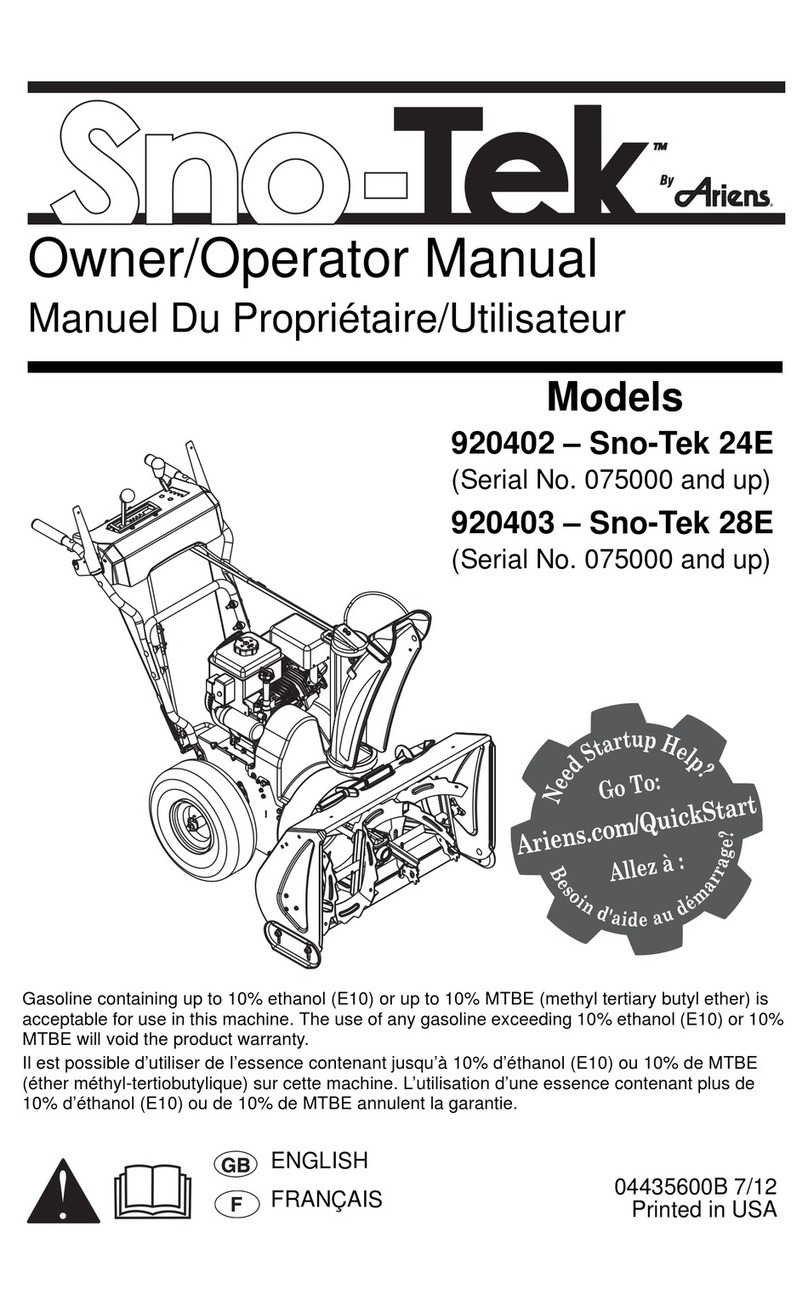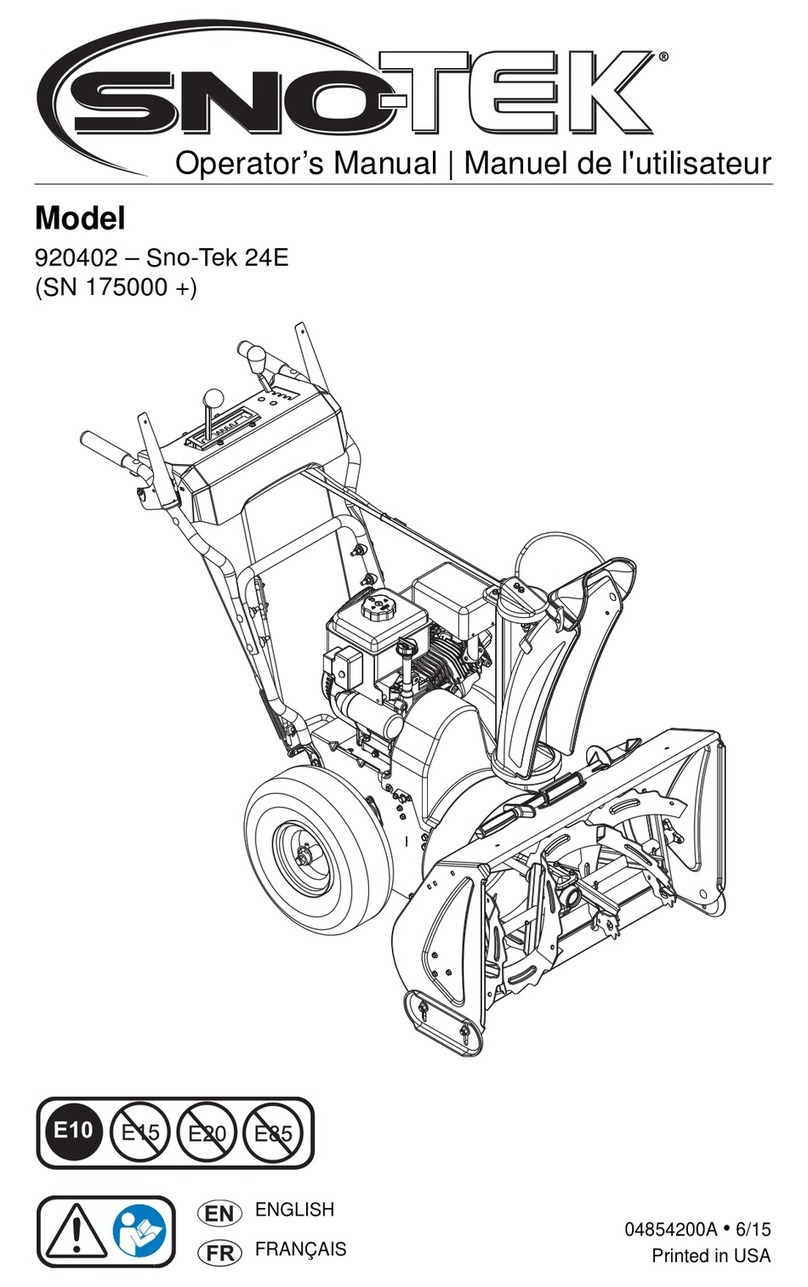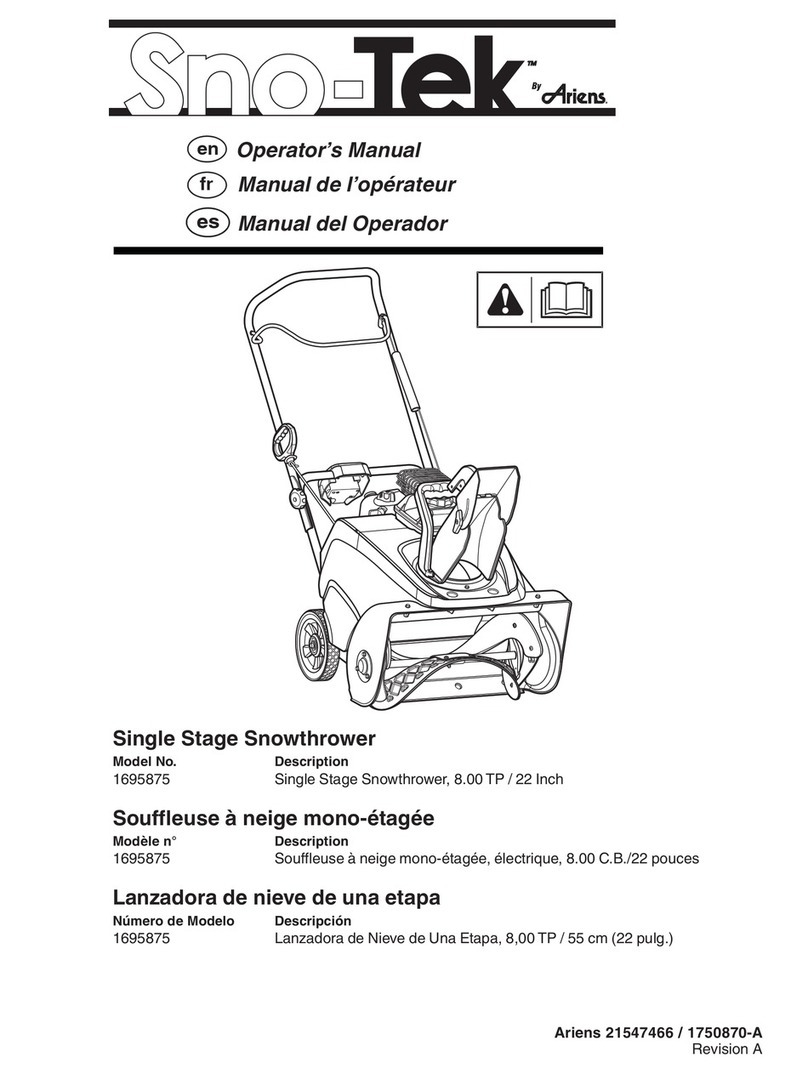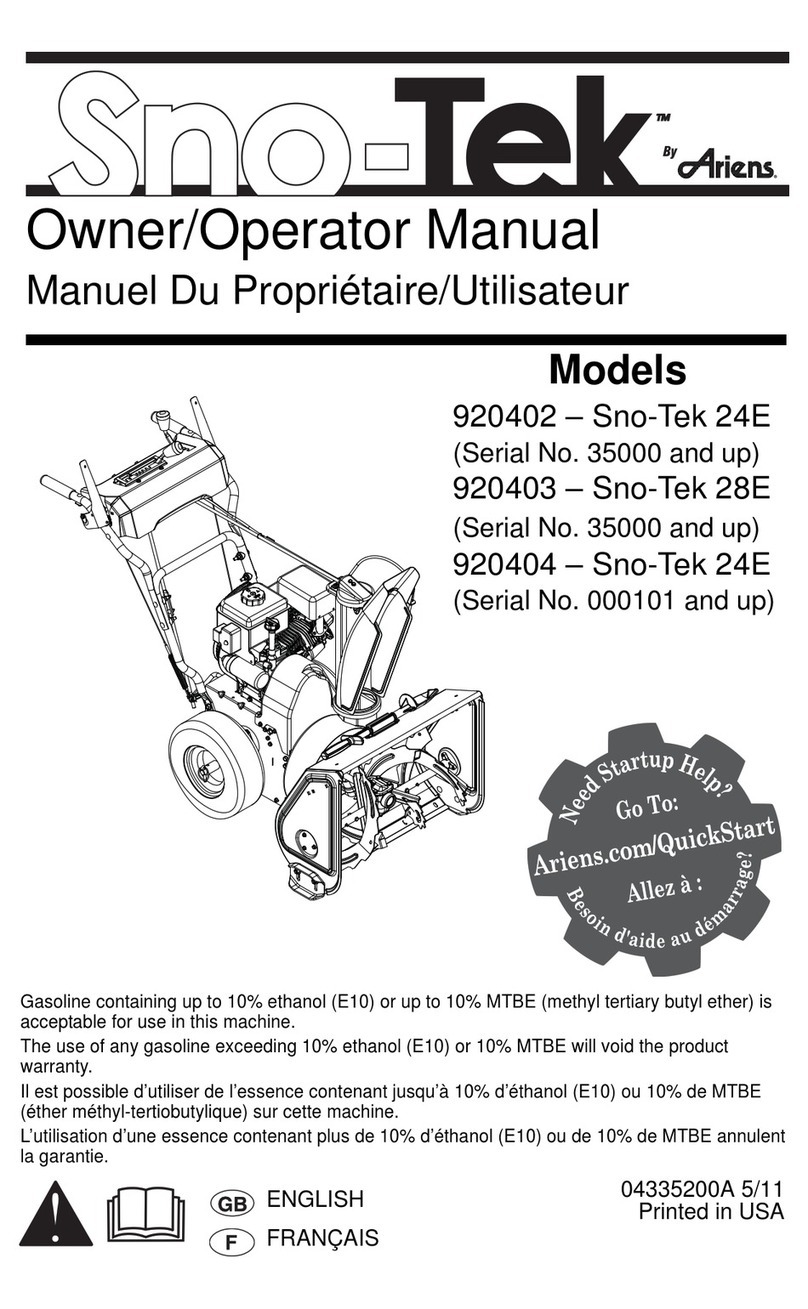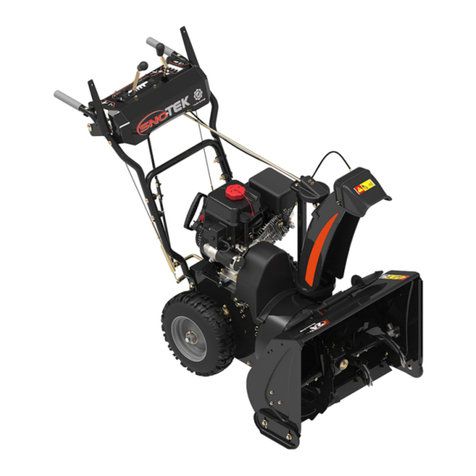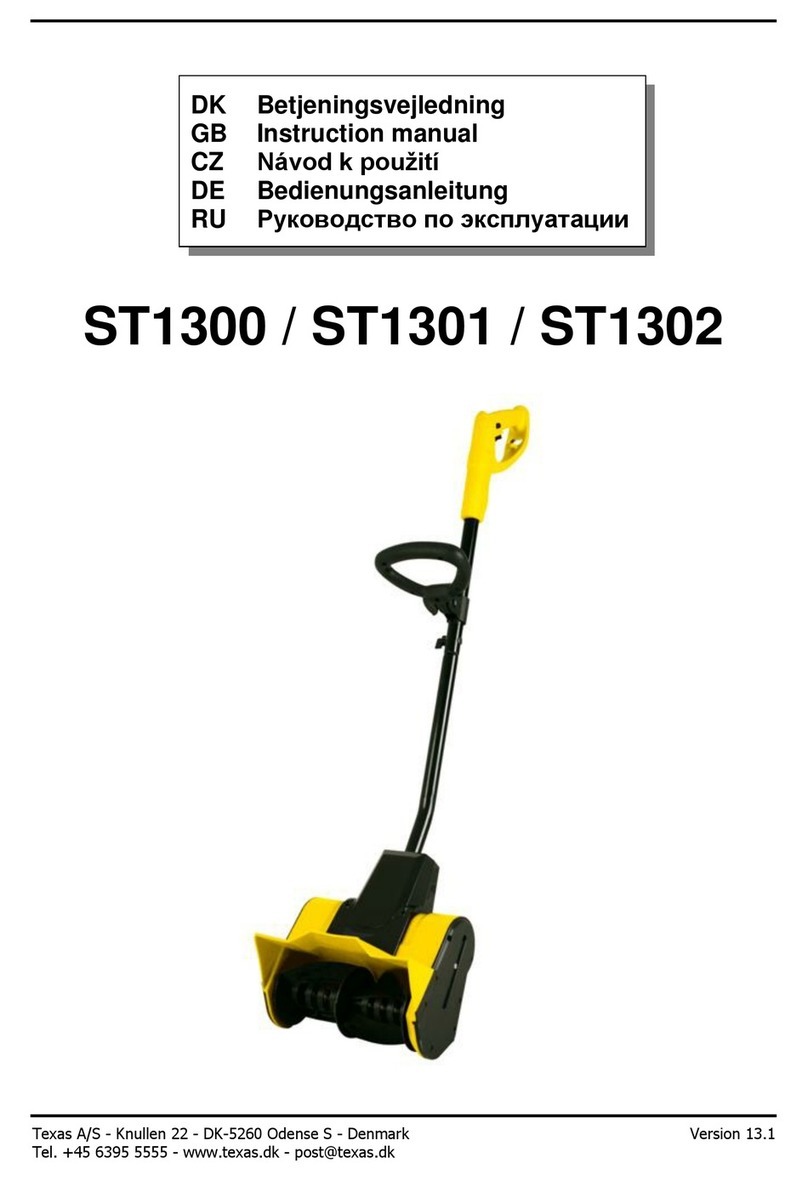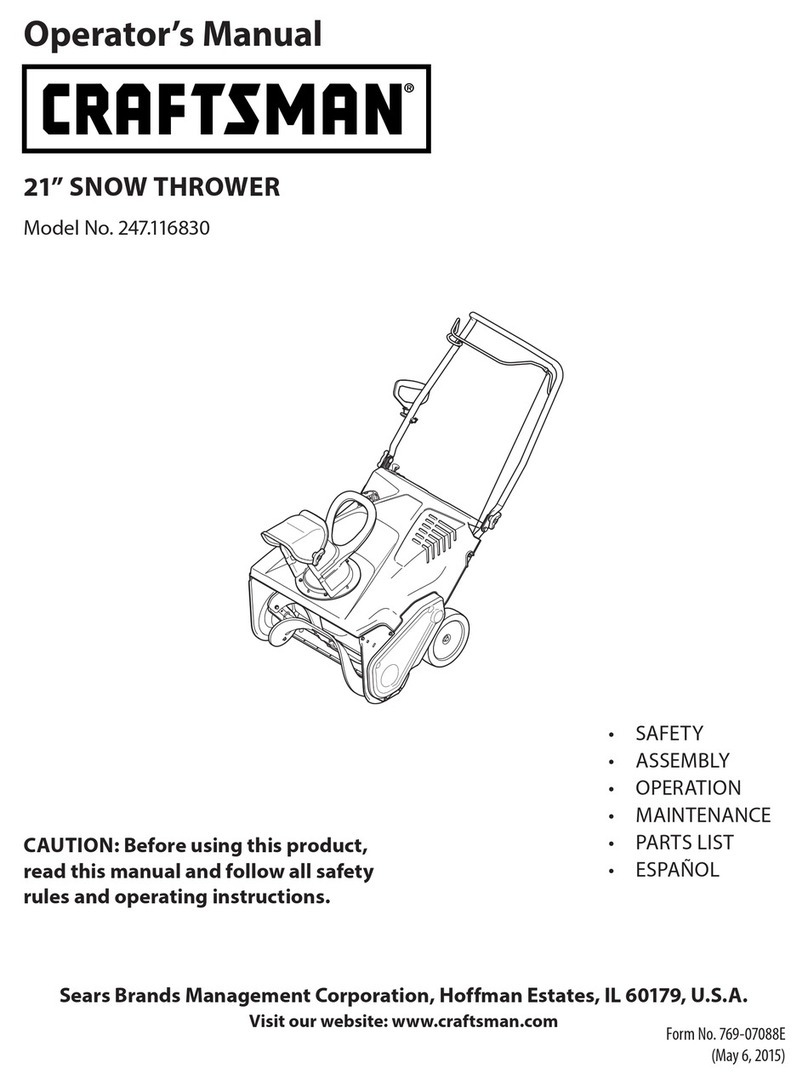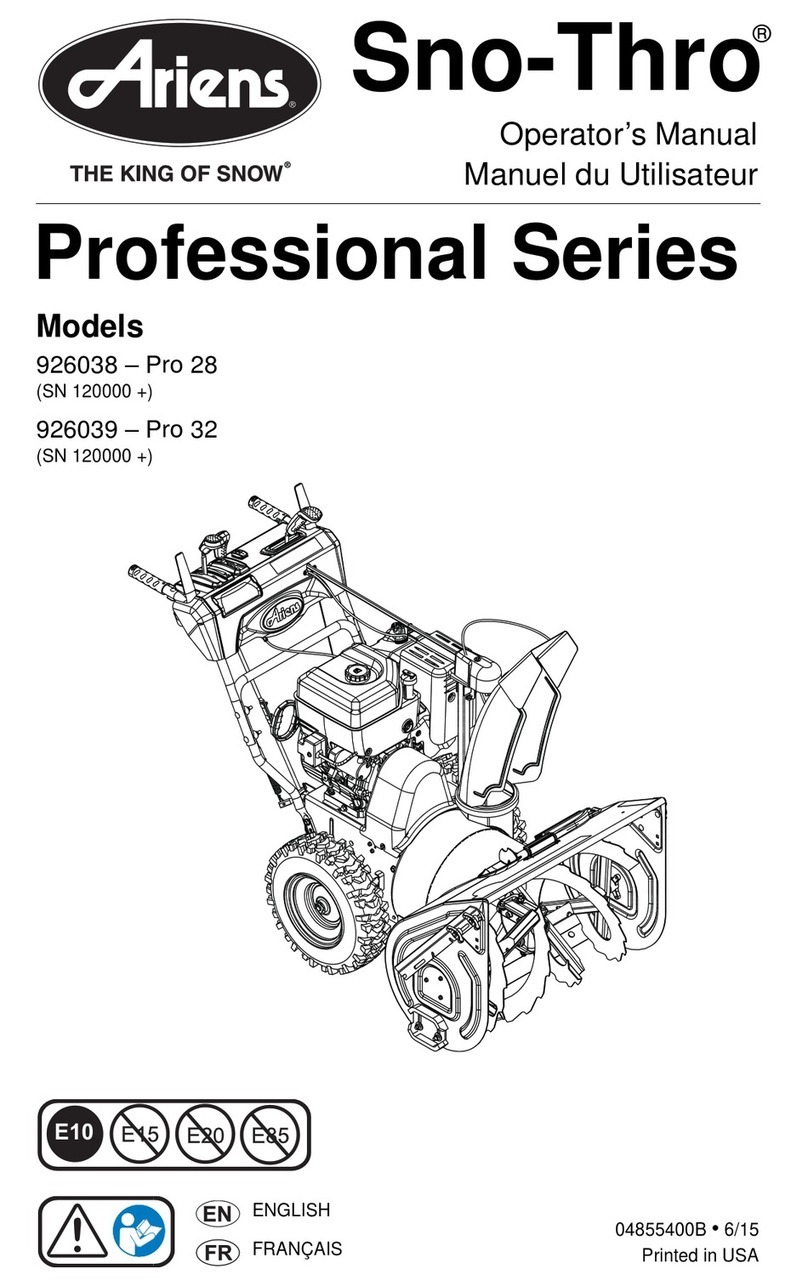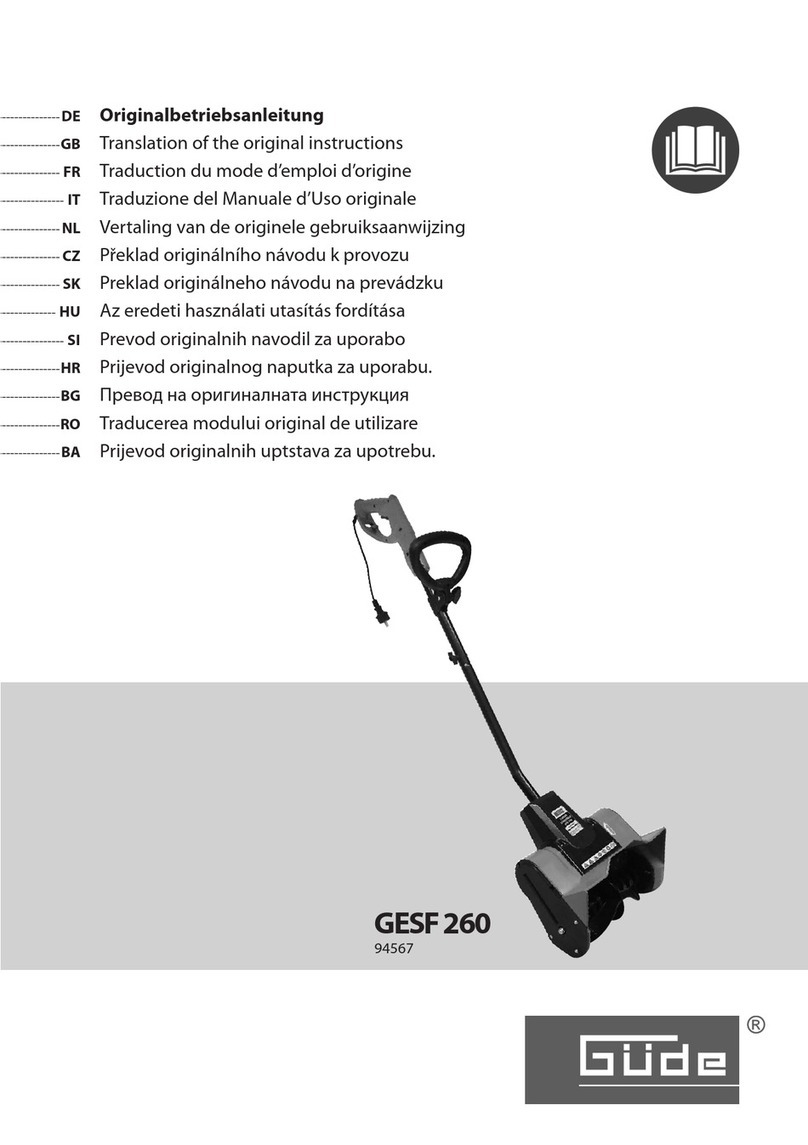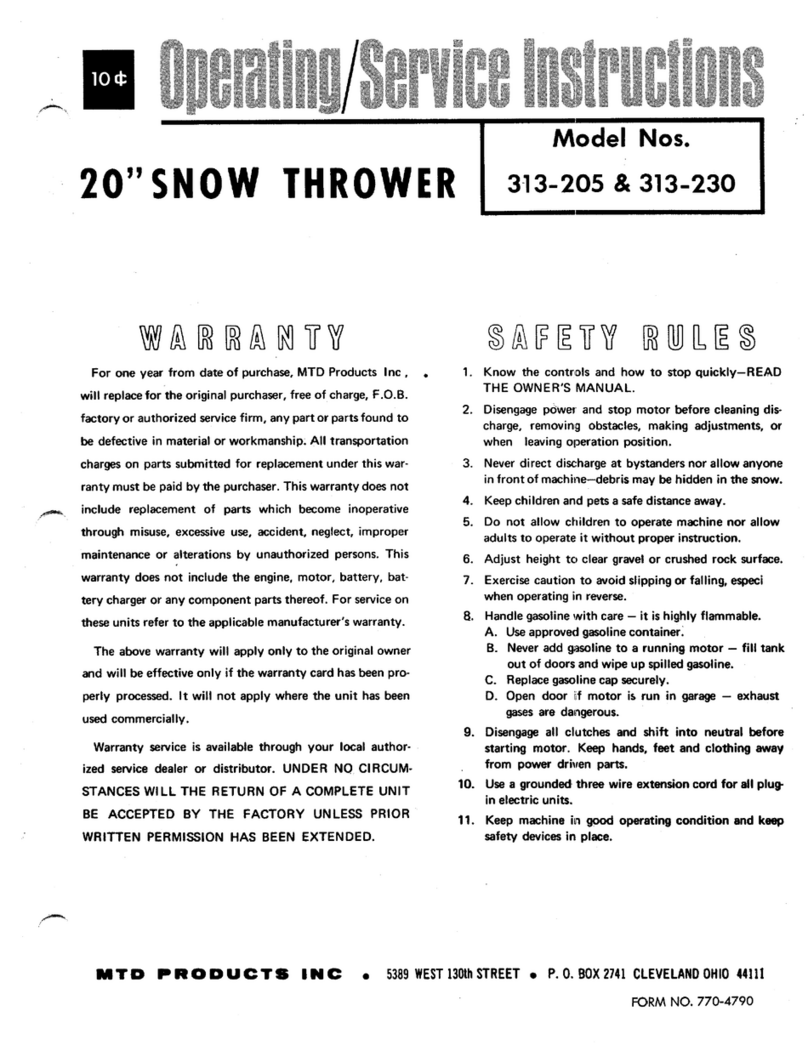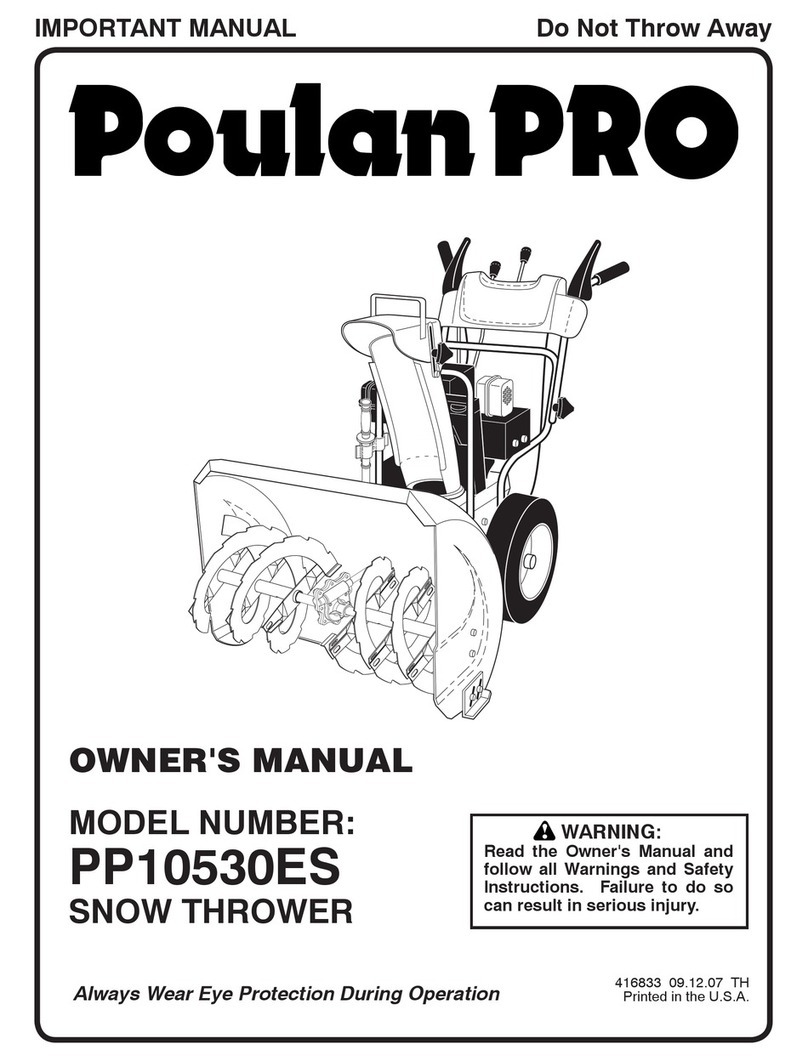Sno-Tek 24E User manual

Owner/Operator Manual
Manuel Du Propriétaire/Utilisateur
Models
920402 – Sno-Tek 24E
(Serial No. 35000 and up)
920403 – Sno-Tek 28E
(Serial No. 35000 and up)
920404 – Sno-Tek 24E
(Serial No. 000101 and up)
04335200C 11/11
Printed in USA
ENGLISH
FRANÇAIS
Gasoline containing up to 10% ethanol (E10) or up to 10% MTBE (methyl tertiary butyl ether) is
acceptable for use in this machine. The use of any gasoline exceeding 10% ethanol (E10) or 10%
MTBE will void the product warranty.
Il est possible d’utiliser de l’essence contenant jusqu’à 10% d’éthanol (E10) ou 10% de MTBE
(éther méthyl-tertiobutylique) sur cette machine. L’utilisation d’une essence contenant plus de
10% d’éthanol (E10) ou de 10% de MTBE annulent la garantie.

GB - 2
SAFETY. . . . . . . . . . . . . . . . . . . . . . . . . . 4
ASSEMBLY . . . . . . . . . . . . . . . . . . . . . . . 9
CONTROLS and FEATURES . . . . . . . . 14
OPERATION . . . . . . . . . . . . . . . . . . . . . 15
MAINTENANCE . . . . . . . . . . . . . . . . . . 20
SERVICE AND ADJUSTMENTS . . . . . 23
STORAGE. . . . . . . . . . . . . . . . . . . . . . . 30
SERVICE PARTS . . . . . . . . . . . . . . . . . 31
ACCESSORIES. . . . . . . . . . . . . . . . . . . 31
TROUBLESHOOTING . . . . . . . . . . . . . 31
SPECIFICATIONS. . . . . . . . . . . . . . . . . 33
WARRANTY . . . . . . . . . . . . . . . . . . . . . 34
NON-ENGLISH MANUALS
Manuals in languages other than
English may be obtained from your
dealer. Visit your dealer or
www.ariens.com for a list of
languages available for your
equipment.
Manuals printed in languages other
than English are also available as a
free download on our website:
http://www.ariens.com
MANUALES EN IDIOMAS
DIFERENTES DEL INGLES
Puede obtener manuales en
idiomas diferentes del inglés en su
distribuidor. Visite a su distribuidor
o vaya a www.ariens.com para
obtener una lista de idiomas
disponibles para su equipo.
También puede imprimir manuales
en idiomas diferentes del inglés
descargándolos gratuitamente de
nuestra página Web:
http://www.ariens.com
MANUELS NON ANGLAIS
Des manuels dans différentes
langues sont disponibles chez
votre revendeur. Rendez-vous
chez votre revendeur ou allez sur
le site www.ariens.com pour
consulter la liste des langues
disponibles pour votre équipement.
Les manuels imprimés dans des
langues différentes de l'anglais
sont également disponibles en
téléchargement gratuit sur notre
site Web :
http://www.ariens.com
MANUALS
Before operation of unit, carefully and
completely read your manuals. If used
improperly, this unit could be dangerous and
cause personal injury or property damage.
The contents will provide you with safety
instructions for the safe use of your unit
during normal operation and maintenance.
All reference to left, right, front, or rear are
given from operator standing in operation
position and facing the direction of forward
travel.
ENGINE MANUAL
The engine on this unit is covered by a
separate manual specific to the engine. This
manual is included in the literature package
that shipped with the unit. Refer to this
manual for engine service recommendations.
If the engine manual is not available, contact
the engine manufacturer for a replacement
manual.
MODEL AND SERIAL NUMBERS
When ordering replacement parts or making
service inquiries, know the Model and Serial
numbers of your unit and engine.
Numbers are located on the product
registration form in the unit literature
package. They are printed on a serial number
label, located on the frame of your unit
(Figure 1).
TABLE OF CONTENTS
INTRODUCTION

GB - 3
• Record unit model and serial numbers
here.
• Record engine model and serial
numbers here.
PRODUCT REGISTRATION
The Ariens dealer must register the product
at the time of purchase. Registering the
product will help the company process
warranty claims or contact you with the latest
service information. All claims meeting
requirements during the limited warranty
period will be honored, whether or not the
product registration card is returned. Keep a
proof of purchase if you do not register your
unit.
Customer Note: If the dealer does not
register your product, please fill out, sign, and
return the product registration card to Ariens
or go to www.ariens.com.
UNAUTHORIZED REPLACEMENT
PARTS
Use only Ariens replacement parts. The
replacement of any part on this vehicle with
anything other than an Ariens authorized
replacement part may adversely affect the
performance, durability, or safety of this unit
and may void the warranty. Ariens disclaims
liability for any claims or damages, whether
warranty, property damage, personal injury or
death arising out of the use of unauthorized
replacement parts. To locate your nearest
Ariens dealer, go to www.ariens.com on the
internet.
DISCLAIMER
Ariens reserves the right to discontinue,
make changes to, and add improvements
upon its products at any time without public
notice or obligation. The descriptions and
specifications contained in this manual were
in effect at printing. Equipment described
within this manual may be optional. Some
illustrations may not be applicable to your
unit.
DELIVERY
Customer Note: If you have purchased this
product without complete assembly and
instruction by your retailer, it is your
responsibility to:
1. Read and understand all assembly
instructions in this manual. If you do not
understand or have difficulty following
the instructions, contact your nearest
Ariens dealer for assistance. Make sure
all assembly has been properly
completed.
NOTE: To locate your nearest Ariens dealer,
go to www.ariens.com on the Internet.
2. Understand all safety precautions
provided in the manuals.
3. Review control functions and operation
of the unit. Do not operate the unit
unless all controls function as described
in this manual.
4. Review recommended lubrication,
maintenance and adjustments.
5. Review limited warranty policy.
6. Fill out a product registration card and
return the card to the Ariens Company or
go to www.ariens.com.
Figure 1
Serial Number Label
WARNING: Improper assembly or
adjustments can cause serious
injury.

GB - 4
SAFETY ALERTS
Look for these symbols to point
outimportantsafetyprecautions.
They mean:
Attention!
Personal Safety Is
Involved!
Become Alert!
Obey The Message!
The safety alert symbols above and signal
words below are used on decals and in this
manual. Read and understand all safety
messages.
NOTATIONS
NOTE: General reference information for
proper operation and maintenance practices.
IMPORTANT: Specific procedures or
information required to prevent damage to
unit or attachment.
PRACTICES AND LAWS
Practice usual and customary safe working
precautions, for the benefit of yourself and
others. Understand and follow all safety
messages. Be alert to unsafe conditions and
the possibility of minor, moderate, or serious
injury or death. Learn applicable rules and
laws in your area. Always follow the practices
set forth in this manual.
REQUIRED OPERATOR
TRAINING
Original purchaser of this unit was instructed
by the seller on safe and proper operation. If
unit is to be used by someone other than
original purchaser; loaned, rented or sold,
ALWAYS provide this manual and any
needed safety training before operation.
SAFETY DECALS AND
LOCATIONS
ALWAYS replace missing or damaged safety
decals. Refer to figure below for safety decal
locations.
SAFETY
WARNING: To avoid injury to hands
and feet, always disengage clutches,
shut off engine, and wait for all
movement to stop before unclogging
or working on snow thrower.
Hand contact with the rotating
impeller is the most common cause of
injury associated with snow throwers.
Never use your hand to clean out the
discharge chute.
Keep hands and feet away from
auger and impeller.
DANGER: IMMINENTLY
HAZARDOUS SITUATION! If not
avoided, WILL RESULT in death or
serious injury.
WARNING: POTENTIALLY
HAZARDOUS SITUATION! If not
avoided, COULD RESULT in death or
serious injury.
CAUTION: POTENTIALLY
HAZARDOUS SITUATION! If not
avoided, MAY RESULT in minor or
moderate injury. It may also be used
to alert against unsafe practices.
1
3
Figure 2
2

GB - 5
1. DANGER!
Danger!
ONLY use clean-out tool to
clear blockages. NEVER
use your hands.
Never direct discharge
towards persons or
property that may be
injured or damaged by
thrown objects.
Keep people away from
unit while operating. Keep
children out of work area
and under watchful care of
a responsible adult.
Stop engine, remove key,
read manual before
making any repairs or
adjustments.
Read Owner/Operator
Manual.
Wear appropriate hearing
protection.
2. DANGER!
Danger!
ROTATING PARTS! ONLY
use clean-out tool to clear
blockages. NEVER use
your hands. High speed
impeller rotates below
discharge opening. Wait
for all moving parts to
stop before removing
clogs or servicing.
3. DANGER!
Danger!
ROTATING PARTS.
Keep clear of auger while
engine is running.
• Read Operator’s
Manual.
• Allow operation only by
properly trained adult,
never children.
• Stop engine and
remove ignition key
prior to leaving the
operator’s position for
any reason.
• Keep all controls,
guards and safety
devices properly
serviced and functional.
• Never direct discharge
towards persons or
property that may be
injured or damaged by
thrown objects.
OL4690

GB - 6
EMISSION CONTROL SYSTEM
This equipment and/or its engine may include
exhaust and evaporative emissions control
system components required to meet U.S.
Environmental Protection Agency (EPA)
and/or California Air Resources Board
(CARB) regulations. Tampering with
emission controls and components by
unauthorized personnel may result in severe
fines or penalties. Emission controls and
components can only be adjusted by an
Ariens Company dealer or an authorized
engine manufacturer's service center.
Contact your Ariens Company Equipment
Retailer concerning emission controls and
component questions.
SAFETY RULES
Read, understand, and follow all safety
practices in owner/operator manual before
beginning assembly or operating. Failure to
follow instructions could result in personal
injury and/or damage to unit.
ALWAYS remove key and/or wire from spark
plug before assembly, maintenance or
service. Unintentional engine start up can
cause death or serious injury.
Complete a walk around inspection of unit
and work area to understand:
• Work area • Your unit • All safety decals
ALWAYS check overhead and side
clearances carefully before operation.
ALWAYS be aware of traffic when operating
along streets or curbs.
Keep children and people away. Keep
children out of work area and under watchful
care of a responsible adult.
NEVER allow children to operate or play on
or near unit. Be alert and shut off unit if
children enter area.
DO NOT allow adults to operate unit without
proper training. Only trained adults may
operate unit. Training includes actual
operation.
Keep area of operation clear of all toys, pets,
and debris. Thrown objects can cause injury.
Check for weak spots on docks, ramps or
floors. Avoid uneven work areas and rough
terrain. Stay alert for hidden hazards.
DO NOT operate near drop-offs, ditches, or
embankments. Unit can suddenly turn over if
a wheel is over the edge of a cliff or ditch, or if
an edge caves in.
Falling snow, fog, etc. can reduce vision and
cause an accident. Operate unit only when
there is good visibility and light.
NEVER operate unit after or during the use of
medication, drugs or alcohol. Safe operation
requires your complete and unimpaired
attention at all times.
NEVER allow anyone to operate this unit
when their alertness or coordination is
impaired.
DO NOT operate unit without wearing
adequate winter outer garments. Wear
adequate safety gear, including safety
glasses with side shields, and protective
gloves. Wear proper footwear to improve
footing on slippery surfaces.
DO NOT wear loose clothing or jewelry and
tie back hair that may get caught in rotating
parts.
Protect eyes, face and head from objects that
may be thrown from unit. Wear appropriate
hearing protection.
Avoid sharp edges. Sharp edges can cut.
Moving parts can cut off fingers or a hand.
ALWAYS keep hands and feet away from all
rotating parts during operation. Rotating parts
can cut off body parts.
NEVER place your hands or any part of your
body or clothing inside or near any moving
part while unit is running.
ALWAYS keep hands away from all pinch
points.
DO NOT touch unit parts which might be hot
from operation. Allow parts to cool before
attempting to maintain, adjust or service.
Never direct discharge towards persons or
property that may be injured or damaged by
thrown objects. Use extreme caution on
gravel surfaces. Stay alert for hidden hazards
or traffic. Adjust skid shoes so scraper blade
does not contact gravel.
DO NOT throw snow any higher than
necessary.
Deflected materials can cause injury and
property damage.
Always stand clear of the discharge area
when operating this unit.
Fumes from engine exhaust can cause injury
or death. DO NOT run engine in an enclosed
area. Always provide good ventilation.
ALWAYS disengage attachment, stop unit
and engine, remove key and allow moving
parts to stop before leaving operator’s
position.
ROTATING IMPELLER CAN CAUSE
SERIOUS INJURY. NEVER ATTEMPT TO
UNCLOG OR CLEAN UNIT WHILE ENGINE
IS RUNNING.

GB - 7
Read, understand, and follow all instructions
in the manual and on the machine before
starting.
Understand:
How to operate all controls.
The functions of all controls.
How to STOP in an emergency.
Before starting engine, disengage control(s).
ALWAYS allow unit and engine to adjust to
outdoor temperatures before clearing snow.
Always be sure of your footing, especially
when operating in reverse or leaving the
operator’s position. Walk, never run during
operation.
DO NOT overload the machine capacity by
attempting to operate or to clear snow at too
fast a rate.
Slow down and turn corners slowly.
Do not operate in reverse unless absolutely
necessary. ALWAYS back up slowly. Always
look down and behind before and while
backing.
Disengage attachment drive when traveling
from one work area to another.
Abnormal vibrations are a warning of trouble.
Striking a foreign object can damage unit.
Immediately stop unit and engine. Remove
key and wait for all moving parts to stop.
Remove wire from spark plug. Inspect unit
and make any necessary repairs before
restart.
Before cleaning, removing clogs or making
any inspections, repairs, etc.: disengage
clutch(es), stop unit and engine, remove key,
allow moving parts to stop. Allow hot parts to
cool.
Run unit a few minutes after clearing snow to
prevent freeze-up of attachment.
Disengage attachment when not in use.
Disengage all clutches before starting engine.
Adjust skid shoes to clear gravel or crushed
rock surfaces safely.
Never leave a running unit unattended.
ALWAYS shut off engine before leaving unit.
ALWAYS remove key to prevent unauthorized
use.
Never carry passengers.
Check clutch and brake operation frequently.
Adjust and service as required. All motion of
drive wheels and auger/impeller must stop
quickly when control levers are released.
DO NOT operate on steep slopes. DO NOT
clear snow across the face of slopes. Keep all
movement on slopes slow and gradual. DO
NOT make sudden changes in speed or
direction. Use a slow speed to avoid stops or
shifts on slopes. Avoid starting or stopping on
a slope.
DO NOT park unit on a slope unless
absolutely necessary. When parking on a
slope always block the wheels.
ALWAYS shut off engine, remove key, and
close fuel shut-off valve or drain fuel when
transporting unit on a truck or trailer.
Use extra care when loading or unloading
unit onto trailer or truck.
Secure unit chassis to transport vehicle.
NEVER secure from rods or linkages that
could be damaged.
DO NOT transport machine while engine is
running.
Keep unit free of ice or other debris. Clean up
oil or fuel spills.
This product is equipped with an internal
combustion type engine. DO NOT use unit on
or near any unimproved, forest-covered or
brush covered land unless exhaust system is
equipped with a spark arrester meeting
applicable local, state or federal laws. A spark
arrester, if it is used, must be maintained in
effective working order by operator.
Fuel is highly flammable and its vapors are
explosive. Handle with care. Use only an
approved gasoline container with an
appropriately sized dispensing spout.
NO smoking, NO sparks, NO flames.
ALWAYS allow engine to cool before
servicing.
NEVER fill fuel tank when engine is running
or hot from operation.
NEVER fill or drain fuel tank indoors.
Replace fuel cap securely and clean up
spilled fuel.
Never fill containers inside a vehicle or on a
truck or trailer bed with a plastic liner. Always
place containers on the ground away from
your vehicle before filling.
When practical, remove gas-powered
equipment from the truck or trailer and refuel
it on the ground. If this is not possible, then
refuel such equipment on a trailer with a
portable container, rather than from a
gasoline dispenser nozzle.
Keep the nozzle in contact with the rim of the
fuel tank or container opening at all times until
fueling is complete. Do not use a nozzle lock-
open device.

GB - 8
If fuel is spilled on clothing, change clothing
immediately.
Properly remove fuel before tipping unit up
onto housing, so no spills will occur.
Secure unit so it will not tip over during
maintenance.
ALWAYS keep protective structures, guards,
and panels in good repair, in place and
securely fastened. NEVER modify or remove
safety devices.
DO NOT change engine governor settings or
over-speed engine.
Fumes from engine exhaust can cause injury
or death. DO NOT run engine in an enclosed
area. Always provide good ventilation.
ALWAYS maintain unit in safe operating
condition. Damaged or worn out muffler can
cause fire or explosion.
Keep all hardware properly tightened. Check
shear bolts frequently.
Maintain or replace safety and instruction
labels, as necessary.
NEVER store unit with fuel in fuel tank, inside
a building where any ignition sources are
present such as hot water heaters, space
heaters, or clothes dryers. Allow the engine to
cool before storing in any enclosure.
Shut off fuel and allow engine to cool
completely before storing in closed area or
covering unit.
For extended storage, clean unit thoroughly.
See engine manual for proper storage.
Use only attachments or accessories
designed for your unit.
Check components frequently. If worn or
damaged, replace with manufacturer’s
recommended parts.

GB - 9
PACKAGE CONTENTS
ASSEMBLY
WARNING: AVOID INJURY. Read
and understand the entire Safety
section before proceeding.
WARNING: Dropping or tipping over
boxed unit could result in personal
injury or damage to unit.
PACKAGE CONTENTS
Check the contents of your package for the
parts listed below (Figure 3):
Item Part No. Qty Description
The following parts are included as part of
the Sno-Tek™ Unit:
1. N/A 1 Sno-Tek™ Unit
2. 06221600 4 5/16 in-18 x 2-1/4 in.
Serrated Head
Flange Bolt
The following parts are included as a part of
the Lower Handlebar:
3. 00597451 1 Lower Handlebar
4. 07500005 4 Handlebar Spacer
5. 06435700 4 Flat Steel Washer
6. 06407400 4 Locking Washer
7. 06530200 4 5/16 in-18 Locking
Nylon Nut
8. N/A 1 Upper Handlebar
Assembly
9. N/A 1 Discharge Chute
Assembly
10. 62011500 1 Chute Crank
Assembly
11. N/A 1 Literature Pack
12. 07028500 2 3/8 in-16 x 3/4 in.
Bolts
If any of the above listed contents are
missing contact your local Ariens dealer.
Figure 3
1
3
12
8
911
10
2
5
6
74

GB - 10
ASSEMBLY
Tools Required:
• Pliers
• Open-End Wrenches: 3/8, 7/16, 1/2,
9/16 in. and/or Adjustable Wrench
•TireGauge
• Torque Wrench (Optional)
Unfold Lower Handlebar
(Figure 4)
1. Remove wheel pins from each side of
the unit and slide wheels away from
frame (Figure 4). Do not remove wheels
completely.
NOTE: Be sure to block wheels or secure unit
so it does not move during assembly.
.
2. Remove 5/16 in-18 x 2-1/4 in. serrated
head flange bolt from the mounting
holes on each side of the frame. Keep
bolts.
3. Rotate lower handlebar out from unit so
lower handlebar mounting holes align
with mounting holes on the unit frame.
4. Secure lower handlebar to unit using the
two 3/8 in-16 x 3/4 in. boltss removed in
step 2.
5. Tighten all four bolts to 25 – 42 lbf-ft
(33.9 – 56.9 N•m)
6. Slide both wheels back into place and
reinstall wheel pins.
Attach Upper Handlebar Assembly
(Figure 5 and 6)
1. Remove handlebar hardware from lower
handlebar. Keep hardware.
2. Attach upper handlebar assembly to
lower handlebar using two sets of the
handlebar hardware removed in step 1.
One set to attach each side of the
handlebars (Figure 5).
IMPORTANT: DO NOT tighten hardware.
Allow upper handlebar assembly to hang
from the lower handlebars for the next step.
.
3. Hook spring end of attachment control
cable to the clutch arm.
4. Hook spring end of the traction control
cable to the cable eyelet on back of
frame.
.
Figure 4
2
1
31. Lower Handlebar
2. Wheel Pin
3. Wheel
4. Mounting Holes
5. 5/16 in-18 x 2-1/4 in. Serrated
Head Flange Bolt
5
4
Figure 5
3
4
2
1. Upper Handlebar Assembly
2. Lower Handlebar
3. 5/16 in-18 x 2-1/4 in. Bolt
4. Handlebar Spacer
5. Flat Steel Washer
6. Locking Washer
7. 5/16 in-18 Locking Nylon Nut
1
765
Figure 6
3
1. Clutch Arm
2. Cable Eyelet
3. Attachment Control Cable
4. Traction Control Cable
1
4
2

GB - 11
Unfold Upper Handlebar Assembly
(Figure 7 and 8)
1. Rotate the handlebar into operating
position.
NOTE: Be careful not to damage cable spring
hooks when rotating handlebar upward.
.
2. Install the remaining handlebar
hardware attaching the upper handlebar
assembly to the lower handlebar
(Figure 5).
3. Tighten all hardware.
4. Remove packaging around shift rod.
5. Rotate shift rod into place and tighten
hardware.
6. Connect shift rod to speed selector arm
and adjust as specified in Speed
Selector Adjustment on page 24.
7. Remove slack from attachment and
traction cables using the following steps
(Figure 8):
a. Loosen jam nut on cable
adjustment barrel
b. Turn the adjustment barrel down
to shorten cable and remove all
cable slack.
c. Retighten jam nut.
Install Discharge Chute
(Figure 9)
1. Remove mounting hardware from the
bottom of the chute pedestal.
2. Install discharge chute over opening in
the auger housing and secure pedestal
to auger housing with hardware
removed in step 1.
Figure 7
1
2
3
1. Shift Rod
2. Handlebar Hardware
3. Upper Handlebar Assembly
4. Lower Handlebar
4
Figure 8
1. Attachment Clutch Cable
2. Cable Adjustment Barrel
3. Jam Nut
2
3
OS8260
1
Figure 9
3
1
3
2
1. Mounting Hardware
2. Discharge Chute
3. Chute Pedestal
1

GB - 12
Install Discharge Chute Crank
(Figure 10)
1. Slide chute crank through the support
bracket.
NOTE: Be careful not to damage nylon
bushing when attaching crank to the dash.
2. Connect the chute crank to the pinion
gear on chute with spring clip pin.
Install Remote Deflector Cable
(920402, 403)
(Figure 11 and 12)
1. Slide cable through clip on top of
discharge chute pedestal (Figure 11).
2. Bend clip closed around cable.
3. Using the wire hook attached to the
deflector cable, hook cable to discharge
chute crank.
4. Pull rubber seal cap away from snap
fitting.
5. Install snap fitting into cable bracket’s
mounting hole located under the dash.
6. Position rubber seal cap over the top of
snap fitting.
7. Move deflector control lever to rear most
position.
8. Attach cable eye to pin on bottom of
deflector control lever.
NOTE: Hold down chute deflector cap, if
needed, for more cable slack.
9. Secure cable eye to control lever with
washer and hairpin.
10. Test controls to be sure deflector works
properly.
If deflector does not follow full range of travel
See Remote Discharge Deflector Control
Adjustment (920402, 403) on page 24.
Figure 10
1. Chute Crank
2. Support Bracket
3. Pinion Gear
4. Spring Clip Pin
1
2
3
4
1
3
2
4
5
Figure 11
1. Remote Deflector Cable
2. Remote Deflector Control
3. Cable Clip
4. Wire Cable Hook
5. Cable Mounting Bracket

GB - 13
Check Function of Dual Handle
Interlock
Without the engine running, press down
(engage) both clutch levers. Release
attachment clutch lever. Attachment clutch
should remain engaged until traction clutch
lever is released, then both clutches must
disengage. If they do not, contact your dealer
for repairs.
Check Tire Pressure
Check tire pressure and adjust to the
pressure listed on tire sidewall.
Check Auger Gearcase Oil
Check oil level in auger gearcase (see Check
Auger Gearcase on page 21).
Check Engine Crankcase Oil
IMPORTANT: The engine is shipped with
5W-30 oil in crankcase. Refer to engine
manual for detailed instructions.
Fill Engine Fuel Tank
Fill fuel tank. DO NOT OVERFILL! See Filling
Fuel Tank on page 18.
Check Function of all Controls
Ensure unit runs and performs properly. Refer
to Operation.
Run-in Attachment Belt
1. Start unit in a well-ventilated area
according to Starting and Shut Off on
page 19.
2. Engage attachment clutch lever and run
attachment for about 15 minutes.
3. Stop unit, wait for all moving parts to
stop, and remove spark plug wire.
4. Adjust belt finger, if necessary. See
Check Belt Finger Clearance on
page 27.
5. Adjust clutch idler according to
Attachment Clutch/Brake Adjustment on
page 25.
1. Mounting Hole
2. Snap Fitting
3. Rubber Seal
Cap
4. Hairpin
5. Washer
6. Cable Eye
Figure 12
2
1
3
4
6
5
CAUTION: Avoid injury! Explosive
separation of tire and rim parts is
possible when they are serviced
incorrectly:
• Do not attempt to mount a tire
without the proper equipment
and experience to perform the
job.
• Do not inflate the tires above
the recommended pressure.
• Do not weld or heat a wheel
and tire assembly. Heat can
cause an increase in air
pressure resulting in an
explosion. Welding can
structurally weaken or deform
the wheel.
• Do not stand in front or over
the tire assembly when
inflating. Use a clip-on chuck
and extension hose long
enough to allow you to stand
to one side.

GB - 14
1. Attachment Clutch Lever
2. Speed Selector
3. Traction Drive Clutch Lever
4. Chute Crank
5. Muffler Guard
6. Manual Discharge Chute Deflector
(920404)
Remote Discharge Chute Deflector
(920402, 403)
7. Discharge Chute
8. Impeller
9. Auger
10. Scraper Blade
11. Auger Gearcase
12. Clean-out Tool
13. Oil Fill and Dipstick (920402, 403)
14. Gas Tank and Cap
15. Recoil Starter Handle
16. Primer Bulb
17. Ignition Switch (Push /Pull)
18. Engine Shutoff Switch
19. Choke
20. Axle Lock Pin
21. Skid Shoe(s)
22. Belt Cover
23. Fuel Shut-off Valve
24. Handlebar
25. Electric Starter
26. Remote Deflector Control Lever
(920402, 403)
27. Oil Fill and Dipstick (920404)
CONTROLS AND FEATURES
Figure 13
123
456
7
8
9
10
11
12
21
22
20
13
14
15
24
16
19
17
23
18
15
25
26
27

GB - 15
CONTROLS AND FEATURES
See Figure 13 for all Controls and Features
locations.
Dual Handle Interlock
When attachment clutch and then traction
drive clutch are engaged, the attachment
clutch will remain engaged (lever down) if
released. To stop attachment, release traction
drive clutch and both clutches will disengage.
Traction Drive Clutch –
Left Hand LeverSqueeze the traction drive
clutch lever against the
handlebar (1) to engage
wheel drive for propelling
unit. Forward speed will
vary according to snow
depth and moisture
content.
Release lever (2) to stop
movement.
NOTE: When traveling to or from the area to
be cleared, press down on the handlebars
enough to raise the front of the unit slightly off
the surface. Engage the traction drive clutch
without engaging the attachment drive clutch.
Attachment Clutch –
Right Hand Lever Squeeze attachment
clutch lever against
handlebar (1) to
engage attachment.
Release both clutch
levers (2) to disengage
power and apply brake
to attachment.
IMPORTANT: If the
belt squeals when the
attachment clutch lever
is engaged, the
impeller may be frozen in the auger housing.
Immediately release the attachment clutch
lever and move the unit into a heated area to
thaw.
NOTE: If belt squeals when impeller turns
freely, see Attachment Clutch/Brake
Adjustment on page 25.
Ignition Switch
(Push/Pull Safety Key)
Key Switch has two positions:
1. “Stop” – pulled out
2. "Run" – pushed in
NOTE: DO NOT twist key after it is inserted.
Engine Shutoff Switch
1. Set the engine shutoff switch to the run
position ("Run") to start and operate the
engine.
2. Set the engine shutoff switch to the stop
position ("Stop") to shut off a running
engine.
Primer Bulb Pushing the primer bulb in
adds fuel for easier engine
start. Refer to Starting and
Shut Off on page 19.
OPERATION
WARNING: AVOID INJURY. Read
and understand the entire Safety
section before proceeding.
WARNING: To avoid injury to hands
and feet, always disengage clutches,
shut off engine, and wait for all
movement to stop before unclogging
or working on snow thrower.
Keep hands and feet away from
auger and impeller.
1
2
OL2701
1
2
OL2691
2
1

GB - 16
Speed Selector
Position the speed selector in the appropriate
speed notch to control forward and reverse
travel.
Forward: (6) Fastest
(1) Slowest
Reverse: (1) Slow
(2) Fast
IMPORTANT: DO NOT change motion from
forward to reverse with clutch engaged.
Forward speed can be changed without
declutching.
Fuel Shut-Off Valve
IMPORTANT: The fuel shut-off valve MUST
be in the closed position prior to transporting
the unit.
The fuel shut-off valve has two positions:
Open Position (1):
Use this position to
run the unit.
Closed Position (2):
Use this position to
service, transport, or
store the unit.
Choke Control
1. Choke Closed position: chokes off air to
engine for easier start.
2. Choke Open position: allows for normal
operation.
IMPORTANT: Gradually open choke after
engine starts.
Recoil Starter Handle
When pulled, handle will turn engine over.
IMPORTANT: DO NOT let handle snap back
against starter.
See Starting and Shut Off on page 19.
Snow Clean-Out Tool
(Figure 14)
To clear the discharge chute:
1. Shut off the engine.
2. Wait 10 seconds and make sure impeller
blades have stopped rotating.
3. Remove the snow clean-out tool (1) from
the auger housing and use it to remove
the clog from the discharge chute.
4. Replace the snow clean-out tool on the
auger housing.
Manual Discharge Chute Deflector
(920404)
ALWAYS position discharge chute deflector
at a safe angle before starting engine.
DO NOT throw snow any higher than
necessary.
Push deflector handle forward or down to
throw snow lower. Pull deflector handle up or
to the rear to throw snow higher.
08000712
OFF
ON
1
2
START
RUN
2
1
WARNING: Hand contact with the
rotating impeller is the most common
cause of injury associated with snow
throwers. Never use your hand to
clean out the discharge chute.
1
Figure 14
1. Snow Clean-Out Tool

GB - 17
IMPORTANT: If chute deflector does not stay
in set position, adjust as directed in SERVICE
AND ADJUSTMENTS on page 23, or repair
before operation.
Remote Discharge Chute Deflector
Control (920402, 403)
Place deflector into position before operation.
DO NOT throw snow any higher than
necessary.
Place deflector remote in a forward notch to
throw snow lower. Place deflector remote in a
rearward notch to throw snow higher.
Discharge Chute
Discharge chute rotates 205°.
ALWAYS position discharge chute in safe
direction and angle, away from operator and
bystanders, before starting engine.
Discharge Chute Crank
IMPORTANT: If chute does not stay in set
position, adjust as directed in SERVICE AND
ADJUSTMENTS on page 23,or repair before
operation.
Rotate the chute with the discharge chute
crank handle.
IMPORTANT: DO NOT force frozen chute
controls. If frozen, take to warm place until
controls are free.
Axle Lock Pin
(Figure 15)
Use the axle lock pin to lock or unlock the
right or left wheel. Lock both wheels to
increase traction; unlock one wheel to allow
for easier turning of the unit.
NOTE: Unit will not drive with both wheels
unlocked.
Scraper Blade
The scraper blade allows better contact with
the surface being cleared. It also prevents
damage to the housing from wear.
IMPORTANT: DO NOT allow scraper blade to
wear too far or auger/impeller housing will
become damaged.
Skid Shoes
The skid shoes control the distance between
the scraper blade and the ground. Adjust skid
shoes equally to keep blade level with the
ground. Refer to Pre-Start on page 18 for
recommended settings.
Figure 15
Wheel Unlocked
Wheel Locked
Axle Lock
Pin

GB - 18
FILLING FUEL TANK
GASOLINE
IMPORTANT: ALWAYS use gasoline that
meets the following guidelines:
• Clean, fresh gasoline.
• A minimum of 87 octane/87 AKI (91
RON). High altitude use may require a
different octane. Consult your engine
manual.
• Gasoline with up to 10% ethanol
(gasohol) or up to 10% MTBE (methyl
tertiary butyl ether) is acceptable.
• Use of any gasoline other than those
approved above will void the engine
warranty. If the pumps are not marked
for the content of alcohol or ethers,
check ethanol and MTBE levels with
the fuel supplier.
• Do not modify the fuel system to use
different fuels.
• Never mix oil and gasoline.
NOTE: All gasoline is not the same. If the
engine experiences starting or performance
problems after using a new gasoline, switch
to a different fuel provider or fuel brand.
IMPORTANT: Excessively oxygenated or
reformulated fuels (fuels blended with
alcohols or ethers) can damage the fuel
system or cause performance problems. If
any undesirable operating problems occur,
use a gasoline with a lower percentage of
alcohol or ether.
Add Fuel Stabilizer to
Extend Fuel Storage Life
IMPORTANT: Fuel stabilizer is recommended
for extended storage (see Fuel System on
page 31).
Add Fuel to Fuel Tank
1. ALWAYS place unit in open or well-
ventilated area.
2. Stop engine and allow to cool.
3. Clean Fuel Cap and surrounding area to
prevent dirt from entering Fuel Tank.
4. Remove fuel caps.
IMPORTANT: Refer to Engine Manual for
correct type and grade of fuel.
5. Fill fuel tank to the bottom of filler neck.
See SPECIFICATIONS on page 33 for
fuel tank capacity.
IMPORTANT: DO NOT OVERFILL! This
equipment and/or its engine may include
evaporative emissions control system
components, required to meet EPA and/or
CARB regulations, that will only function
properly when the fuel tank has been filled to
the recommended level. Overfilling may
cause permanent damage to evaporative
emissions control system components. Filling
to the recommended level ensures a vapor
gap required to allow for fuel expansion. Pay
close attention while filling the fuel tank to
ensure that the recommended fuel level
inside the tank is not exceeded. Use a
portable gasoline container with an
appropriately sized dispensing spout when
filling the tank. Do not use a funnel or other
device that obstructs the view of the tank
filling process.
6. Replace fuel cap and tighten.
7. ALWAYS clean up spilled fuel.
PRE-START
4. Frozen Impeller
IMPORTANT: Before starting engine, check
impeller to be sure it is not frozen.
To check impeller:
1. With ignition key switch in “Stop”
position, squeeze attachment clutch
lever to engaged position.
2. Pull recoil starter handle.
3. If impeller is frozen, (cannot pull starter
handle) move unit to a heated area and
thaw to prevent possible damage.
5. Check Function of Clutches
If clutches do not engage or disengage
properly, adjust or repair before operation.
See Attachment Clutch/Brake Adjustment on
page 25.
6. Check Dual Handle Interlock
Without the engine running, press down
(engage) both clutch levers. Release
attachment clutch lever. Attachment clutch
should remain engaged until traction clutch
lever is released, then both clutches must
disengage.
If clutches do not engage or disengage
properly, adjust or repair before operation
(see Attachment Clutch/Brake Adjustment on
page 25).
7. Check Axle Lock Pins
Use the axle lock pins to lock or unlock the
wheels. Lock both wheels to increase
traction; unlock one wheel to allow for easier
turning of the unit.
WARNING: AVOID INJURY. Read
and understand the entire Safety
section before proceeding.

GB - 19
8. Check Skid Shoes
Check and adjust skid shoes (Skid Shoes on
page 23). Allow 1/8 in. (3 mm) between
scraper blade and hard, smooth surface(s).
Allow 7/8 in. (22 mm) between scraper blade
and uneven or gravel surfaces.
9. Check Engine Fuel
& Crankcase Oil
Check and add fuel if required. Check that
the engine crankcase oil is full using dipstick.
Refer to engine manual for detailed
instructions.
TO STOP IN AN EMERGENCY
Immediately release both control levers to
stop unit in an emergency. Stop engine,
remove key and wait for all rotating parts to
stop before leaving operator’s position.
STARTING AND SHUT OFF
IMPORTANT: Allow unit and engine to adjust
to the outdoor temperature before clearing
snow. Before shut-off, run the attachment a
few minutes to prevent impeller freeze-up.
NOTE: Try out each control without the
engine running to see how it works and what
it does.
Manual Start
1. Turn discharge chute straight ahead.
2. Make sure that the traction clutch and
attachment drive clutch levers are fully
disengaged.
3. Push primer bulb 2 or 3 times for cold
engine.
NOTE: When temperature is below -15° F
(-26° C) additional priming may be needed.
4. If engine is cold, apply choke. See
engine manual for detailed instructions.
NOTE: A warm engine requires less choking
than a cold engine.
5. Insert key into ignition switch and push
into RUN position. DO NOT twist key
after it is inserted.
6. Turn on the engine shutoff switch
("Run").
7. Grasp starter handle and pull rope out
slowly until it pulls harder. Let rope
rewind slowly.
8. Pull rope with a rapid continuous full arm
stroke. Let rope rewind slowly.
IMPORTANT: DO NOT let starter handle
snap against starter.
9. Repeat steps 7 and 8 until engine starts.
(If engine does not start, refer to
TROUBLESHOOTING on page 31.)
10. Adjust choke as needed.
Electric Start (120V)
1. Connect extension cord to starter.
IMPORTANT: Prevent damage to unit. Know
voltage of your starter and only use matching
outlets.
2. Plug extension cord into 120V 3-wire,
grounded outlet.
IMPORTANT:UseonlyAriensextensioncord
(P/N 02483100) or an equilavent cord that is
rated for a minimum of 13 amps, grounded,
UL listed, CSA certified and labeled as
suitable for outdoor use.
3. Turn discharge chute straight ahead.
4. Make sure that the traction clutch and
attachment drive clutch levers are fully
disengaged.
5. Push Primer Bulb 2 or 3 times for cold
engine.
NOTE: When temperature is below -15° F
(-26° C) additional priming may be needed.
6. Turn on the engine shut off switch "Run".
7. Insert key into ignition switch and push
into RUN position. DO NOT twist key
after it is inserted.
8. If engine is cold, apply choke. A warm
engine requires less choking than a cold
engine. See Engine Manual for detailed
instructions.
9. Press starter button on engine until
engine starts.
IMPORTANT: DO NOT operate starter more
than 15 seconds per minute, as overheating
and damage can occur. (If engine does not
start, refer to TROUBLESHOOTING on
page 31.)
10. Adjust choke as needed.
11. Disconnect power cord from outlet, then
starter.
Shut Off
1. Release traction drive clutch lever and
allow unit to come to a complete stop.
2. Run impeller a few minutes after use to
prevent freeze-up of impeller.
3. Release attachment clutch lever and
wait for all moving parts to come to a
complete stop.
WARNING: AVOID INJURY. Read
and understand the entire Safety
section before proceeding.
WARNING: FAILURE TO FOLLOW
INSTRUCTIONS could result in
personal injury and/or damage to
unit. DO NOT attempt to start your
unit at this time. Read entire
owner/operator manual and the
engine manual first.

GB - 20
4. Turn off the engine shutoff switch
("Stop").
5. Remove key.
SNOW REMOVAL
IMPORTANT: Allow unit and engine to adjust
to the outdoor temperature before clearing
snow.
NOTE: Attachment clutch should be engaged
before wheel drive clutch when throwing
snow.
1. Select speed control position and
direction.
2. Engage attachment clutch – right hand
lever.
3. Engage traction drive clutch – left hand
lever.
IMPORTANT: DO NOT overload unit capacity
by attempting to clear snow at too fast a rate.
Use slow speed to clear deep or hard packed
snow.
Tips for Operation
Snow is best removed as soon as possible
after snow fall.
To clear an area, run unit in an overlapping
series of paths. For large areas, start in the
middle and throw snow to each side, so snow
is not cleared more than once.
ALWAYS direct snow away from area to be
cleared and with direction of the wind.
TRAVELING
To travel from one work area to another:
1. Press down on handlebars enough to
raise front of unit slightly off surface.
2. Engage wheel drive clutch without
engaging attachment drive clutch.
TRANSPORT
ALWAYS shut off engine, remove key, and
close fuel shut-off valve when transporting
unit on a truck or trailer.
Use extra care when loading or unloading
unit onto trailer or truck.
Secure unit chassis to transport vehicle.
NEVER secure from rods or linkages that
could be damaged.
DO NOT transport machine while engine is
running.
Ariens dealers will provide any service or
adjustments which may be required to keep
your unit operating at peak efficiency. Should
engine service be required, contact an Ariens
dealer or an authorized engine
manufacturer's service center.
SERVICE POSITION
(Figure 16)
Place unit on a flat level surface. Tip unit
forward onto front of auger housing for
service. Ensure unit is secure and will not tip
over. Strap and clamp onto bench if needed.
MAINTENANCE
WARNING: AVOID INJURY. Read
and understand the entire Safety
section before proceeding.
WARNING: Before tipping unit up
onto housing, remove fuel so no spills
will occur. Ensure unit is secure and
will not tip over during maintenance.
Figure 16
Service Position
Other manuals for 24E
2
This manual suits for next models
1
Table of contents
Other Sno-Tek Snow Blower manuals
Popular Snow Blower manuals by other brands

Toro
Toro 38083 Operator's manual

Snapper
Snapper LE3171R (7085660 Safety instructions & operator's manual
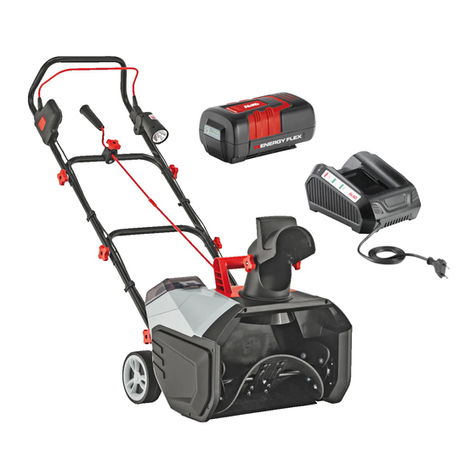
AL-KO
AL-KO ST 4048 Translation of the original instructions for use
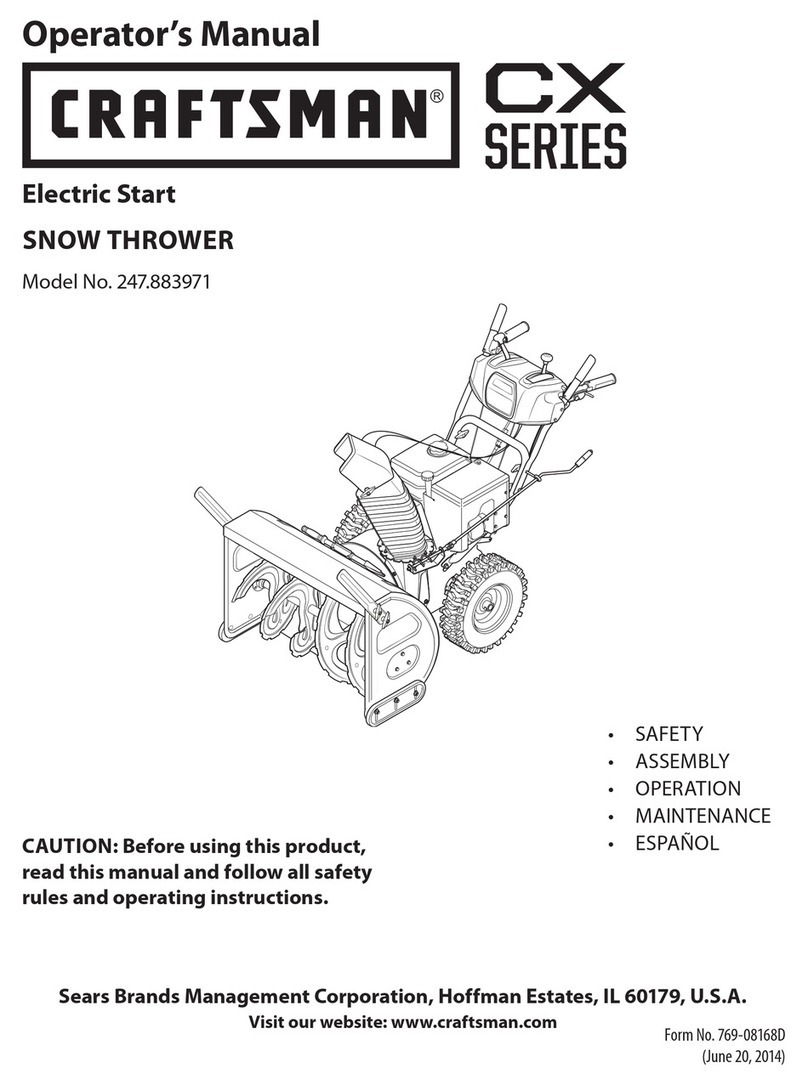
Craftsman
Craftsman CX Series Operator's manual
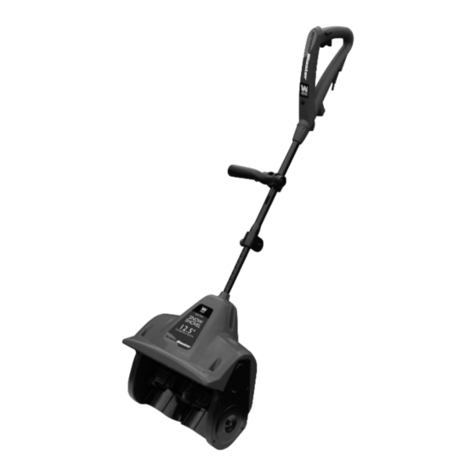
SnowBlaster
SnowBlaster 56660 Operator's manual
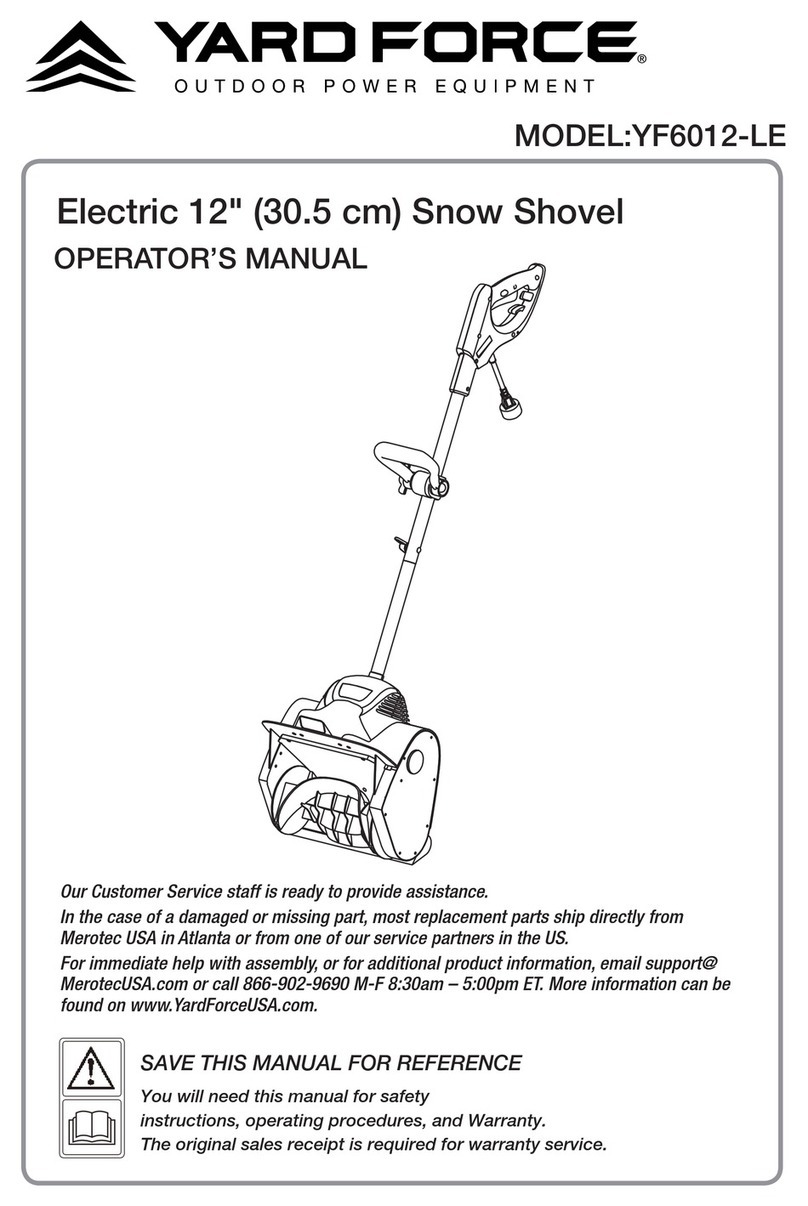
Yard force
Yard force YF6012-LE Operator's manual
